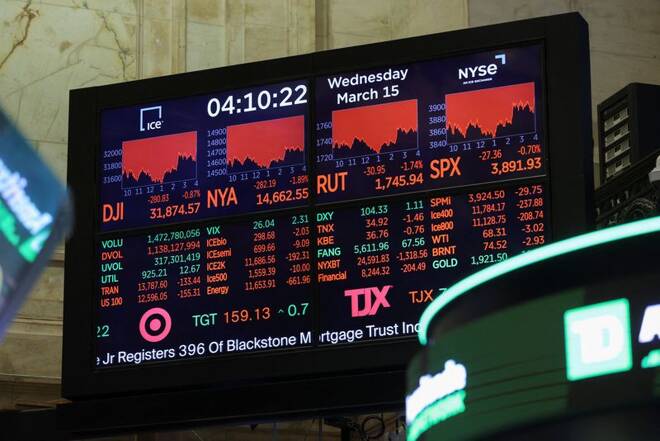Advertisement
Advertisement
Swiss lifeline, ECB dilemma
By:
A look at the day ahead in U.S. and global markets from Mike Dolan
A look at the day ahead in U.S. and global markets from Mike Dolan
A Swiss lifeline to the ailing Credit Suisse has eased some pressure on Europe’s anxious banks but leaves the European Central Bank in a dilemma over whether or not it will aggravate the situation if it goes ahead with a planned interest rate hike on Thursday.
After suffering a withering collapse of its stock and bond prices on Wednesday that jarred global banks once again, Credit Suisse announced it would seek official help and borrow up to $54 billion from the Swiss National Bank to shore up liquidity and investor confidence.
The Swiss lender said it would exercise an option to borrow from its central bank up to 50 billion Swiss francs ($54 billion). That followed assurances from Swiss authorities on Wednesday the country’s second largest bank met “the capital and liquidity requirements imposed on systemically important banks”.
But the reaction was tepid in the CS share price itself and in wider banking, stock and bond markets – roiled over the past week by the reverberations from two bank failures in the United States.
Credit Suisse’s stock, which is down about 70% over the past year and some 25% year to date, bounced from Wednesday’s record low. But – at the time of writing at least – remained down 7% from Tuesday’s close. European bank stocks jumped 2%, but regained only about a third of what they lost Wednesday.
Policymakers and regulators across Europe and Asia rushed to reassure the public and markets that banks in their jurisdictions were safe and well-capitalised. But if public and market confidence, as much as raw balance sheet math, is now the big issue, then it may take more than soothing words.
Much now hinges on how the macro policymakers react and how ECB will respond later on Thursday.
Like other central banks, the ECB has been raising interest rates rapidly to curb inflation and has since July tightened credit at its fastest pace on record.
It had publicly flagged another 50 basis point increase on Thursday, but the banking turmoil surrounding the failure of Silicon Valley Bank at the weekend and Credit Suisse’s near-death experience question the wisdom of that if there’s a risk of a credit crunch from the banking stress anyway.
Interest rates markets have been gyrating wildly all week as a result of the conundrum, trying to second guess whether the Federal Reserve and ECB lean more toward their financial stability rather than strict inflation mandates.
As it stands, money markets now price an 80% chance the ECB will move tentatively and only hike by a quarter point to 2.75%. But already markets now assume the ECB’s peak rate for the cycle will top out at 3% – a full point below where it was only early last week.
The euro bounced slightly from the 2023 lows it hit yesterday, during which it recorded its biggest one-day drop in almost 6 months.
But there was little improvement in U.S. market prices first thing, with S&P500 futures seeing no recovery from another day of heavy losses on Wednesday. The VIX volatility gauge, or ‘fear index’, edged higher again to 26 – about 7 points up from where it was this time last week.
The real eye-watering swings were reserved for U.S. rates and bond yields as markets desperately try to second guess the Fed’s reaction function to all the turmoil ahead of its policymaking meeting next week.
Although futures now see a 66% chance the Fed will raise rates by another quarter point into a 4.75-5.0% range, many economists are now openly doubting whether it will move at all again in this current cycle and there are almost 80bps of rate cuts now priced by year-end.
Two-year Treasury yields, which have been swinging violently back and forth over the past week, were clinging to 4% first thing on Thursday – more than a full percentage point down on last week.
But the extreme volatility in what is seen as a ‘safe’ or ‘risk-free’ asset is troubling in its own right.
Implied volatility gauges for the U.S. Treasury market surged again on Wednesday to their highest since the aftermath of the Lehman Brothers bust in 2008.
The index has doubled in just 6 weeks and its rise since Monday is the second biggest one-week move in the 20-year history of the index.
Elsewhere, geopolitical tensions will do nothing to calm the horses.
China’s foreign ministry said on Thursday the United States had yet to provide evidence that TikTok threatened national security and that the U.S. should stop suppressing such companies.
TikTok, which is owned by Chinese tech giant ByteDance, said on Wednesday President Joe Biden’s administration had demanded TikTok’s Chinese owners divest their stakes in the popular video app or face a possible U.S. ban.
Key developments that may provide direction to U.S. markets later on Thursday:
* US March Philadelphia Fed business survey, NY Fed services sector survey; US Feb export/import prices, housing starts/permits; weekly jobless claims
* European Central Bank policy decision
* US corp earnings: FedEx, Dollar General




(By Mike Dolan, editing by Christina Fincher mike.dolan@thomsonreuters.com. Twitter: @reutersMikeD)
About the Author
Reuterscontributor
Reuters, the news and media division of Thomson Reuters, is the world’s largest international multimedia news provider reaching more than one billion people every day. Reuters provides trusted business, financial, national, and international news to professionals via Thomson Reuters desktops, the world's media organizations, and directly to consumers at Reuters.com and via Reuters TV. Learn more about Thomson Reuters products:
Advertisement
